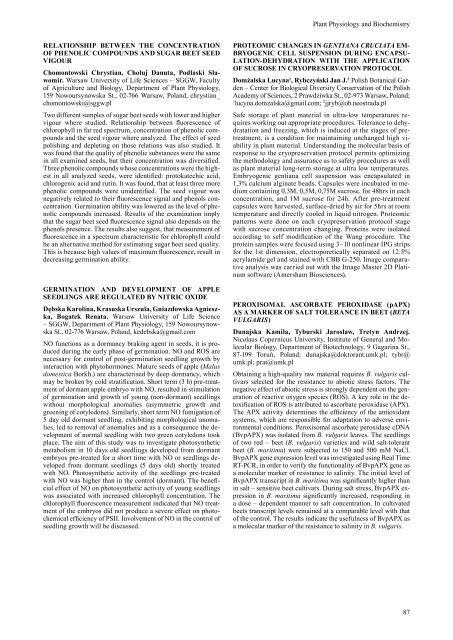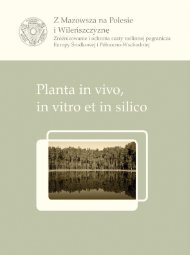acta societatis botanicorum poloniae - LV Zjazd Polskiego ...
acta societatis botanicorum poloniae - LV Zjazd Polskiego ...
acta societatis botanicorum poloniae - LV Zjazd Polskiego ...
Create successful ePaper yourself
Turn your PDF publications into a flip-book with our unique Google optimized e-Paper software.
ELATIONSHIP BETWEEN THE CONCENTrATION<br />
OF PHENOLIC COMPOUNdS ANd SUGAr BEET SEEd<br />
VIGOUr<br />
Chomontowski Chrystian, Chołuj Danuta, Podlaski Sławomir.<br />
Warsaw University of Life Sciences – SGGW, Faculty<br />
of Agriculture and Biology, Department of Plant Physiology,<br />
159 Nowoursynowska St., 02-766 Warsaw, Poland, chrystian_<br />
chomontowski@sggw.pl<br />
Two different samples of sugar beet seeds with lower and higher<br />
vigour where studied. Relationship between fluorescence of<br />
chlorophyll in far red spectrum, concentration of phenolic compounds<br />
and the seed vigour where analyzed. The effect of seed<br />
polishing and depleting on those relations was also studied. It<br />
was found that the quality of phenolic substances were the same<br />
in all examined seeds, but their concentration was diversified.<br />
Three phenolic compounds whose concentrations were the highest<br />
in all analyzed seeds, were identified: protokatechic acid,<br />
chlorogenic acid and rutin. It was found, that at least three more<br />
phenolic compounds were unidentified. The seed vigour was<br />
negatively related to their fluorescence signal and phenols concentration.<br />
Germination ability was lowered as the level of phenolic<br />
compounds increased. Results of the examination imply<br />
that the sugar beet seed fluorescence signal also depends on the<br />
phenols presence. The results also suggest, that measurement of<br />
fluorescence in a spectrum characteristic for chlorophyll could<br />
be an alternative method for estimating sugar beet seed quality.<br />
This is because high values of maximum fluorescence, result in<br />
decreasing germination ability.<br />
GErMINATION ANd dEVELOPMENT OF APPLE<br />
SEEdLINGS ArE rEGULATEd BY NITrIC OxIdE<br />
Dębska Karolina, Krasuska Urszula, Gniazdowska Agnieszka,<br />
Bogatek renata. Warsaw University of Life Science<br />
– SGGW, Department of Plant Physiology, 159 Nowoursynowska<br />
St., 02-776 Warsaw, Poland, kedebska@gmail.com<br />
NO functions as a dormancy braking agent in seeds, it is produced<br />
during the early phase of germination. NO and ROS are<br />
necessary for control of post-germination seedling growth by<br />
interaction with phytohormones. Mature seeds of apple (Malus<br />
domestica Borkh.) are characterised by deep dormancy, which<br />
may be broken by cold stratification. Short term (3 h) pre-treatment<br />
of dormant apple embryo with NO, resulted in stimulation<br />
of germination and growth of young (non-dormant) seedlings<br />
without morphological anomalies (asymmetric growth and<br />
greening of cotyledons). Similarly, short term NO fumigation of<br />
5 day old dormant seedling, exhibiting morphological anomalies,<br />
led to removal of anomalies and as a consequence the development<br />
of normal seedling with two green cotyledons took<br />
place. The aim of this study was to investigate photosynthetic<br />
metabolism in 10 days old seedlings developed from dormant<br />
embryos pre-treated for a short time with NO or seedlings developed<br />
from dormant seedlings (5 days old) shortly treated<br />
with NO. Photosynthetic activity of the seedlings pre-treated<br />
with NO was higher than in the control (dormant). The beneficial<br />
effect of NO on photosynthetic activity of young seedlings<br />
was associated with increased chlorophyll concentration. The<br />
chlorophyll fluorescence measurement indicated that NO treatment<br />
of the embryos did not produce a severe effect on photochemical<br />
efficiency of PSII. Involvement of NO in the control of<br />
seedling growth will be discussed.<br />
Plant Physiology and Biochemistry<br />
PrOTEOMIC CHANGES IN GentiAnA cruciAtA EM-<br />
BrYOGENIC CELL SUSPENSION dUrING ENCAPSU-<br />
LATION-dEHYdrATION WITH THE APPLICATION<br />
OF SUCrOSE IN CrYOPrESErVATION PrOTOCOL<br />
Domżalska Lucyna 1 , Rybczyński Jan J. 2 Polish Botanical Garden<br />
– Center for Biological Diversity Conservation of the Polish<br />
Academy of Sciences, 2 Prawdziwka St., 02-973 Warsaw, Poland;<br />
1 lucyna.domzalska@gmail.com; 2 jjryb@ob.neostrada.pl<br />
Safe storage of plant material in ultra-low temperatures requires<br />
working out appropriate procedures. Tolerance to dehydratation<br />
and freezing, which is induced at the stages of pretreatment,<br />
is a condition for maintaining unchanged high viability<br />
in plant material. Understanding the molecular basis of<br />
response to the cryopreservation protocol permits optimizing<br />
the methodology and assurance as to safety procedures as well<br />
as plant material long-term storage at ultra low temperatures.<br />
Embryogenic gentiana cell suspension was encapsulated in<br />
1,3% calcium alginate beads. Capsules were incubated in medium<br />
containing 0,3M, 0,5M, 0,75M sucrose, for 48hrs in each<br />
concentration, and 1M sucrose for 24h. After pre-treatment<br />
capsules were harvested, surface-dried by air for 5hrs at room<br />
temperature and directly cooled in liquid nitrogen. Proteomic<br />
patterns were done on each cryopreservation protocol stage<br />
with sucrose concentration changing. Proteins were isolated<br />
according to self modification of the Wang procedure. The<br />
protein samples were focused using 3– 10 nonlinear IPG strips<br />
for the 1st dimension, electroporetically separated on 12.5%<br />
acrylamide gel and stained with CBB G-250. Image comparative<br />
analysis was carried out with the Image Master 2D Platinum<br />
software (Amersham Biosciences).<br />
PErOxISOMAL ASCOrBATE PErOxIdASE (pAPx)<br />
AS A MArKEr OF SALT TOLErANCE IN BEET (betA<br />
vulGAris)<br />
dunajska Kamila, tyburski Jarosław, Tretyn Andrzej.<br />
Nicolaus Copernicus University, Institute of General and Molecular<br />
Biology, Department of Biotechnology, 9 Gagarina St.,<br />
87-199 Toruń, Poland; dunajska@doktorant.umk.pl; tybr@<br />
umk.pl; prat@umk.pl<br />
Obtaining a high-quality raw material requires B. vulgaris cultivars<br />
selected for the resistance to abiotic stress factors. The<br />
negative effect of abiotic stress is strongly dependent on the generation<br />
of reactive oxygen species (ROS). A key role in the detoxification<br />
of ROS is attributed to ascorbate peroxidase (APX).<br />
The APX activity determines the efficiency of the antioxidant<br />
systems, which are responsible for adaptation to adverse environmental<br />
conditions. Peroxisomal ascorbate peroxidase cDNA<br />
(BvpAPX) was isolated from B. vulgaris leaves. The seedlings<br />
of two red – beet (B. vulgaris) varieties and wild salt-tolerant<br />
beet (B. maritima) were subjected to 150 and 500 mM NaCl.<br />
BvpAPX gene expression level was investigated using Real Time<br />
RT-PCR, in order to verify the functionality of BvpAPX gene as<br />
a molecular marker of resistance to salinity. The initial level of<br />
BvpAPX transcript in B. maritima was significantly higher than<br />
in salt – sensitive beet cultivars. During salt stress, BvpAPX expression<br />
in B. maritima significantly increased, responding in<br />
a dose – dependent manner to salt concentration. In cultivated<br />
beets transcript levels remained at a comparable level with that<br />
of the control. The results indicate the usefulness of BvpAPX as<br />
a molecular marker of the resistance to salinity in B. vulgaris.<br />
87



